|
This feature is a continuation of Part Two.
The overall objectives of any credible evacuation effort include removing animals that are at risk, not endangering rescuers or animals in the process, relocating them to where they can be properly cared for, and maintaining records so that owners can locate and recover their evacuated animals.
While the response to a sudden emergency may be spontaneous, operations work most efficiently and effectively when guided by some form of practical operational plan. Each operational area should have an Emergency Operations Plan that provides guidance to address various anticipated emergency/disaster needs, including preplanning for large animal evacuation and sheltering. This preplanning includes identifying resources. Use of appropriately trained and equipped volunteers is commonly part of local large animal evacuation and shelter resource planning.
Elements that contribute to effective evacuation operations are illustrated below.
|
|
Effective Evacuation Elements
|
The following list includes several of the elements that need to be considered when organizing a large animal emergency evacuation team.
1. Safe and proper transportation equipment
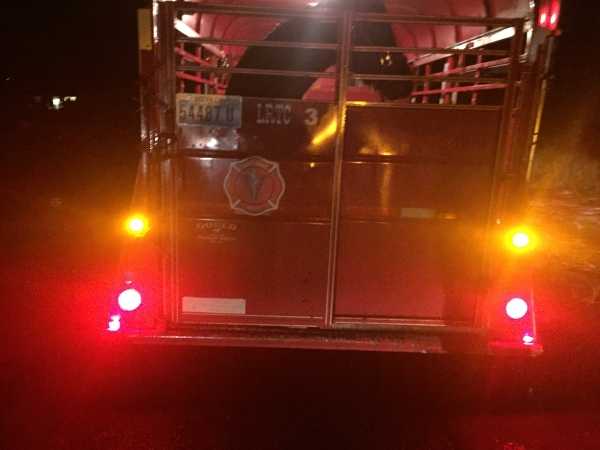
Operations that take place during wide area emergencies usually do not occur during optimum conditions. Some horses will load safely into any trailer. Conversely some people have horses that won't load, or in some instances can't even be handled. Some evacuation scenes are chaotic and can be disturbing to even relatively calm horses.
Generally speaking, trailers used in evacuation teams should be of a stock trailer design where the animals can be herded in without having to be led inside and tied during challenging conditions. They should have sufficient headroom, have sound floors and be free of dangerous defects such as broken structural components or sharp edges. Trailer gates and latches need to work reliably and safety chains should be provided for any latches that could bounce open when traveling over rough terrain. Floorboards must be in sound condition so that they won't fail under peak loads, particularly when exposed to harsh conditions.
Evacuations can occur any time of day, including in darkness. Nighttime operations can be particularly dangerous. Evacuation team trailers must have working low-glare interior lighting and some form of loading and backup lighting.
Trailers need to be maintained properly and inspected regularly. Brakes and brake controllers need to be in proper operating condition. Tail, marker and stop / turn signal lamps need to work properly. DOT red and silver reflective striping should be applied where appropriate.
Wheel bearings are often not thought about and are not repacked frequently enough. Dry bearings that fail during a critical event can put animals and people in jeopardy.
A recurrent issue during evacuation operations involves trailers that arrive with underinflated tires. Tires can only carry their rated loads when inflated to the pressures indicated on the side walls. Underinflation while loaded will impact stability and increase the risk of sudden tire failure. Trailers arriving with low tires should not be allowed to work an incident.
For more detailed information visit Survival School: Preventing Trailer Accidents.
Experience has also shown that some loading will have to be accomplished in awkward locations. Responders must know how to safely and accurately back up their combinations and in many instances 4-wheel-drive tow vehicles are necessary.
You never know where you may end up. Your rolling stock must be up to the task.
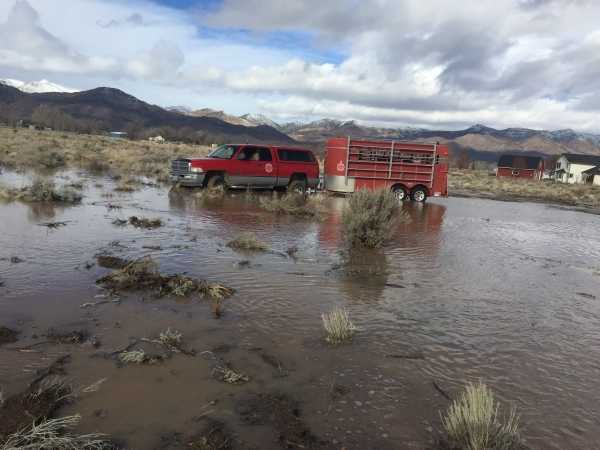
2. Auxiliary Resources
Water Supply
We can't count on water to be available. Many rural areas rely on wells that may not operate when power is cut off. Fire apparatus water tanks are often contaminated with foam or surfactants and are not suitable sources of water. Potable water for livestock at collection points or that are sheltered in place should always be considered, especially during "fire front following" operations.
A 100 gallon portable stock tank is also carried forward of the 400 gallon trailer tank.
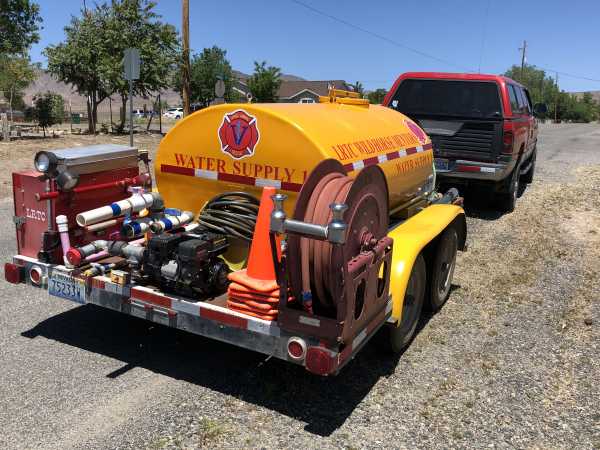
Panel Trailer
Panels may be required for temporary holding, to divide up larger holding areas to separate animals or to build chutes and sorting wells. All the panels are interoperable with the panels carried on transport units.
240 feet of 6 ft. tall structural steel drop pin panels and an extra stock tank.
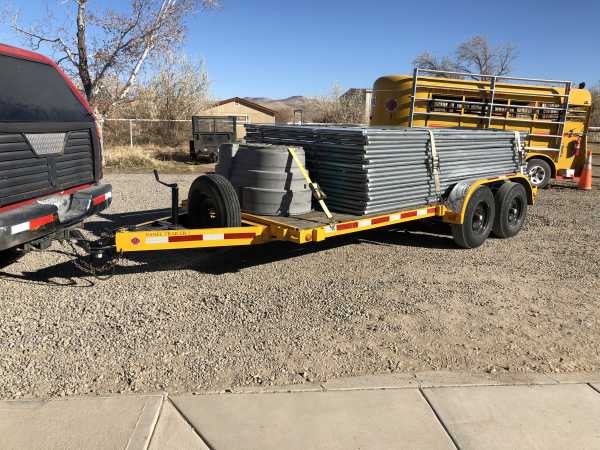
3. Appropriate Basic Training
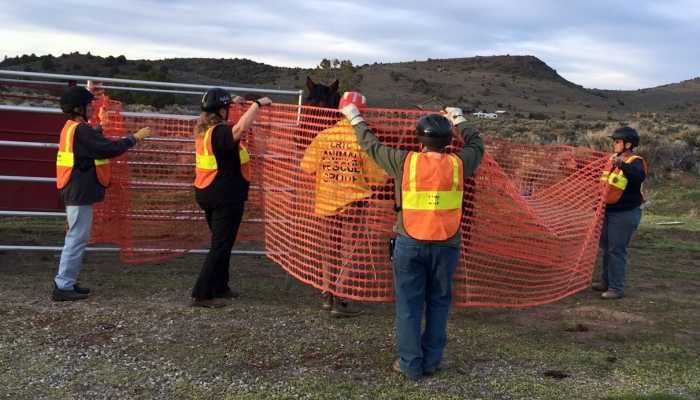
Volunteer responders need to understand how various large animals are likely to react in certain situations, how to use available equipment effectively, how to operate using a low level of energy that reassures rather than upsets the animals, the importance of eliminating unnecessary distractions or disturbances from the loading area, and how to work effectively as a team.
Teamwork involves having someone in charge of the operation, a clear plan established as to how the mission will be accomplished, the various team members being given specific tasks for which they are qualified and remain focused on, good communications among the members so that everyone is aware of all critical information, and a commitment to safe and sane operations. Consistent performance in these areas involves training followed by practice or actual experience.
Safe and effective operations also require a "Work it or leave it" philosophy. Responders typically want to solve all problems that they are presented with. Good judgment must be applied as to whether an operation has a reasonable likelihood of success or if the risks are too high and the likelihood of success is too low.
Threatening conditions must be monitored. Responders must have an awareness of the potential dangers posed by such threats. Training must include an understanding that when conditions reach certain points, it will be necessary to exit the area. Threats can also include agitated animals and disruptive people.
Among the most common impediments to safe and sane evacuations are overly excited or manipulative animal owners. Owners who behave irrationally or are obsessive not only disrupt safe loading practices through distraction and interference, but their behavior can agitate the animals for which removal is being attempted. These impacts can combine to create a clear and present danger for responders.
Argumentative owners who refuse to not interfere with established safe loading practices are not the evacuation team's fault. Micromanaging animal owners can contribute to total operational failure, or at minimum, cause excessive delays that impact the team's ability to respond to other evacuation requests. If there are other active evacuation needs pending, responders must be prepared to tell owners that the team has arrived to help, but if the owners continue to interfere, the team will be moving on to the next call.
(Usually closing the trailer gates and walking back to the cabs of our vehicles gains voluntary compliance.)
For more detailed information visit Safe and Sure Rapid Horse Loading.
4. Appropriate Basic Equipment
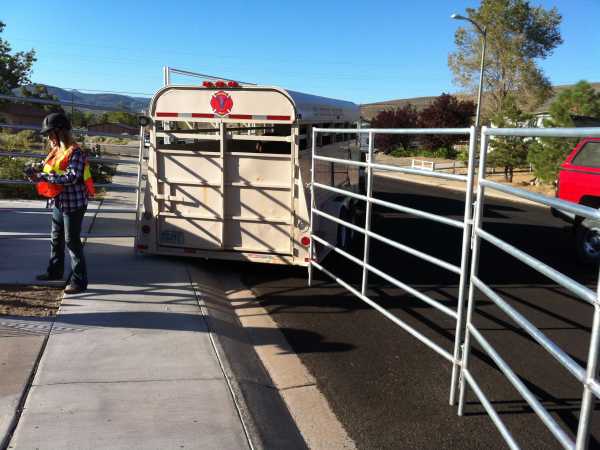
Evacuation teams need to respond with basic compliments of equipment. While not every unit needs to carry everything, designated units need to arrive with specialized gear.
The most useful equipment to facilitate emergency evacuation operations includes:
- Loading panels with standardized drop pin type quick connects (for interoperability with panels carried by other teams.)
- Construction netting (for moving animals into chutes.)
- Lengths of chains with snap links for securing panels and other hardware.
- 36-inch bolt cutters
- Ropes, halters and leads
- Flashlights
- Handheld GMRS/FRS radios
- Logging / tow chain
- Personal safety gear, food, water, first aid kit, etc.
- Maps. (Don't count on cellular network-based mapping to be operational during disasters.)
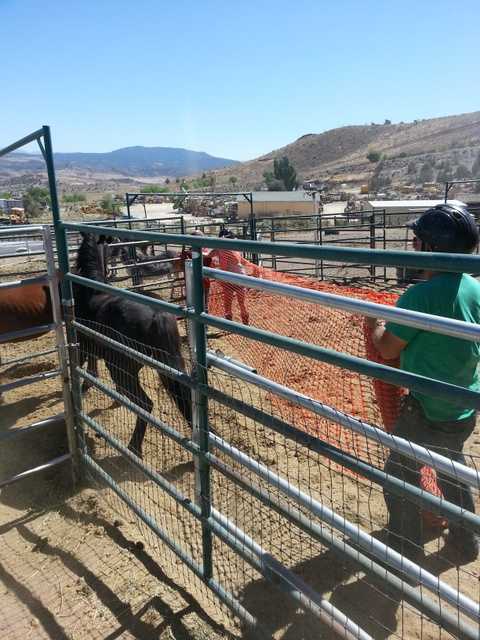
In addition to the above, other useful supplies include supplies to repair cut fencing, flagging ribbon, bright colored duct tape, large permanent markers (to leave messages on duct tape,) sports whistles, glow sticks, cattle marking crayons and forms to record animal descriptions, pickup locations and destinations.
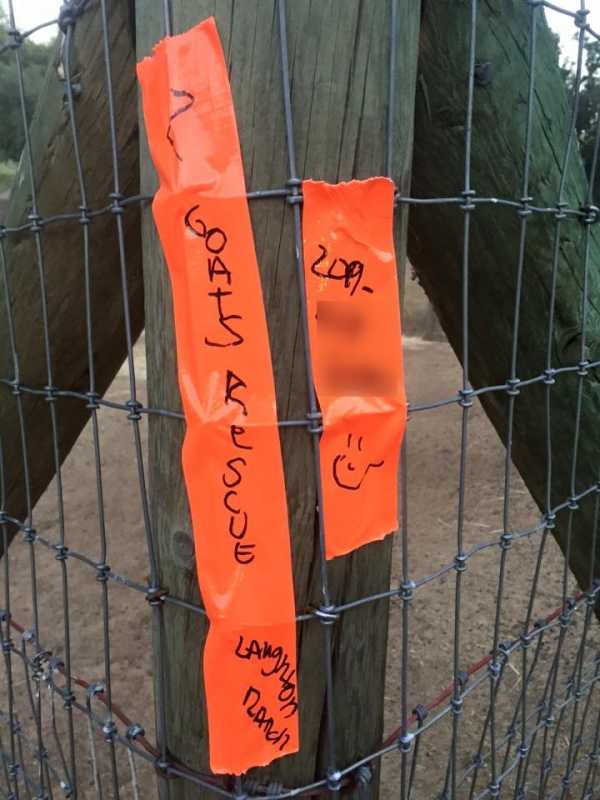
For more detailed information visit
Resource Guide: Emergency Response Trailers.
5. Personal Protective Equipment
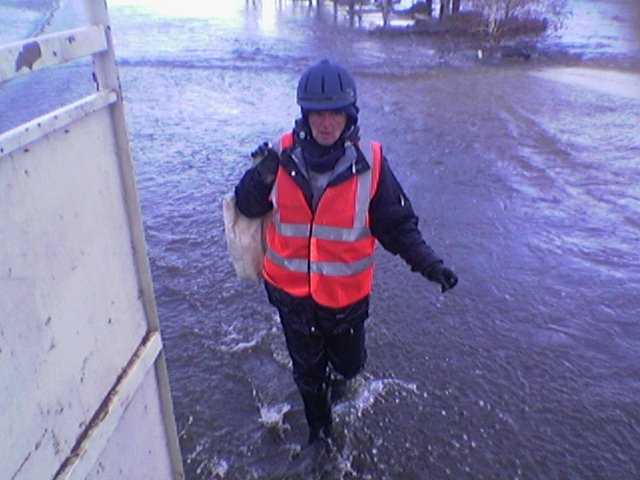
"If you are a victim, you can't be a rescuer."
- Trainer's Corner, Firefighting Canada
For responders' own personal safety and to instill confidence on the part of Incident Commanders that the evac team is credible and not a reincarnation of F-Troop, responders should arrive with appropriate personal protective equipment.
At minimum this equipment should include:
Appropriate clothing for the incident: Proper heavy shoes or boots, work gloves, long pants and long sleeve shirt. For fire responses this clothing should be relatively fire resistant.
Proper helmets for the actions being undertaken. ASTM approved equestrian helmets in good, serviceable condition would be appropriate for general evacuation use. However all-risk Search and Rescue helmets would be more appropriate for high water operations. Forestry fire fighting helmets with goggles would be more appropriate protection from flying brands and radiant heat when operating in fire zones. Chin straps and any internal cushioning / head suspension components should be in good condition.
Proper personal flotation equipment (i.e., life vests) for high water operations.
USFS approved light weight Nomex jackets for operations in fire zones.
ANSI approved reflective outerwear as prescribed by the MUTCD when operating near or on highways.
In addition, responders who may be assigned to work back country evacuations should also carry USFS approved personal fire shelters and have documented training in their use.
Many of these items can be found used (excess) from public agencies while still in serviceable condition.
6. Communications Equipment
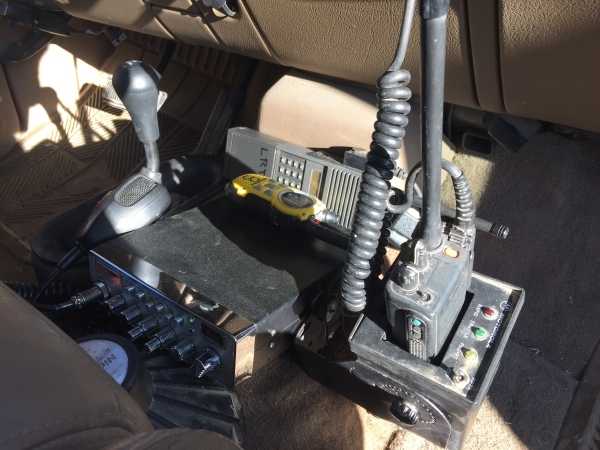
One of the overarching safety considerations that concern Incident Commanders involves being able to account for and communicate with all resources at an emergency scene "real time." There are legitimate professional concerns, and in some states legal ramifications, when command personnel lose track of resources at work within their areas of operation. Maintaining personnel accountability is an even higher priority than being able to convey mission assignments and receiving the results of those mission efforts. There must be some reliable means of communications.
In the field, team leaders must be able to communicate with their members as well as incident superiors. Units must be able to communicate and coordinate with each other. Responders operating in forward positions must be able to receive reports and orders from Safety Officers, lookouts or commanders, particularly if conditions start to deteriorate. Furthermore, the evacuation team's communications equipment must be interoperable with other responding units and the incident's command structure.
Mobile cellular telephones, especially the ability to text instructions to field units and transmit reports from the field to superiors, can be very advantageous. However experience has shown that during major incidents mobile cellular systems can be damaged and fail while at other times the system can become completely overwhelmed with traffic.
How evacuation teams communicate with Incident Commanders is typically a process that falls under the purview of various emergency agencies. This area is one where formally organized teams need to meet and confer with fire, law enforcement and emergency management personnel in order to identify and implement use of an authorized system.
Internally the teams can equip themselves at relatively low cost to facilitate their own communications with commercially available products such as "off the shelf" CB and GMRS/FRS radios.
"Advantages of using CB radios for emergency communications are considerable."
- Emergency Communications, Homeland Security News
One of the most underutilized pieces of readily available communications equipment is the low-tech citizens band (CB) radio. While CB power is limited, the equipment is reasonably priced, does not require a license and can be effective for mobile units to use to communicate with each other when operating in the same general area.
CB radios can be set up in "jump and go" configurations when permanent mounting is not desired. Identifying an otherwise seldom used channel and including it in response pre-plans will facilitate all the responding units coming up on a common channel when mustering.
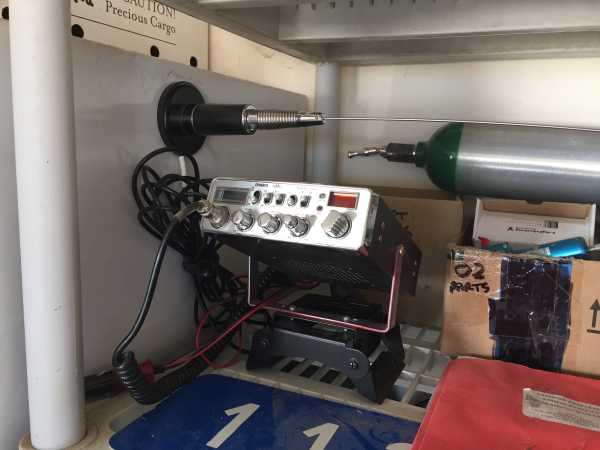
GMRS/FRS handheld radios are relatively compact, do not require a license, and many come with optional compact headsets so the radios can be kept safely tucked in pockets and responders don't have to hold the radios up to their ears in order to receive critical messages. With these radios, everyone working the incident can receive important information and report their conditions and findings to the others without having to shout.
As with CB radios, pre-planning operational channels for GMRS/FRS radios can save time and ensure that everyone in the field is in the "communications loop."
For more detailed information visit
Emergency Communications Systems.
© 2017 Least Resistance Training Concepts. All rights reserved.
Permission to use content and images for non-commercial purposes.
| 




